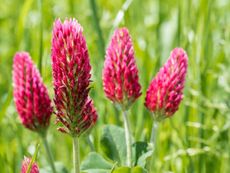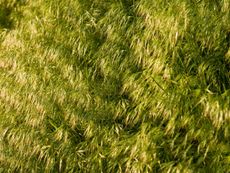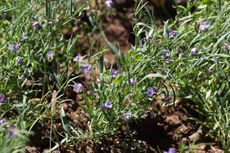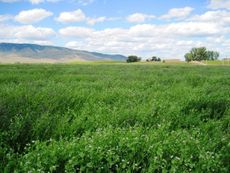Best Cover Crops For Clay Soil: Fixing Clay Soil With Cover Crops


Think of cover crops as living mulch. The term refers to crops you grow to serve some of the same purposes as mulch: to cover and protect fallow soil from weeds and erosion. Cover crops can be tilled back into the soil to improve its nutrients or organic content. This is useful for fixing clay soil with cover crops. Read on for information about cover crop plants for clay soil.
Using Cover Crops to Improve Clay Soil
Clay soil is problematic for gardeners since it is heavy and doesn’t allow water to drain through easily. Many common garden crops and ornamentals require well-draining soil for the best growth. Clay soil has advantages as well as disadvantages. Unlike sandy soil, it holds whatever water and nutrients come its way, but it is heavily goopy when wet and hard as bricks when dry. The key to working with clay soil is to add organic material to it. One way to do this is to start using cover crops to improve clay soil.
Cover Crop Plants for Clay Soil
Since organic matter will make your clay soil easier to work with and better for your plants, your job is to decide what form of organic matter to use. You can work in 6 inches (15 cm.) of raw materials, like chopped leaves or fresh manure, in autumn and allow the soil microbes to break the material into the humus your plants need. Another option, and perhaps an easier one if you have time and patience, is fixing clay soil with cover crops. You’ll have to plan ahead since you want to plant these in your garden well before you plant your veggies or flowers. Depending on the cover crop you choose, you can till these under before they go to seed. Their bulk will both loosen the clay soil and add extra nitrogen to boost the garden crops later.
Best Cover Crops for Clay Soil
Some of the best cover crops for clay soil are clover, winter wheat, and buckwheat. You can also select crops with deep tap roots, like alfalfa and fava beans, to pull nutrients into the topsoil from the subsoil while, at the same time, breaking up the compact clay. Plant these crops in the fall, after the rains begin so that the soil is softer. Allow them to grow all winter, then till them into the soil in the spring before they seed. For maximum organic content, plant a second cover crop in spring to be tilled under in autumn. A full year of cover crops may be what you need to make your garden happy.
Gardening tips, videos, info and more delivered right to your inbox!
Sign up for the Gardening Know How newsletter today and receive a free download of our most popular eBook "How to Grow Delicious Tomatoes."

Teo Spengler has been gardening for 30 years. She is a docent at the San Francisco Botanical Garden. Her passion is trees, 250 of which she has planted on her land in France.
-
 How To Grow Garden To Table: A Guide For Home Cooks
How To Grow Garden To Table: A Guide For Home CooksWhat could be better than a meal that comes directly from garden to table? Show off your gardening and culinary skills with the very freshest food.
By Bonnie L. Grant
-
 Want a Backyard Mini Orchard? Create Your Own Container Orchard
Want a Backyard Mini Orchard? Create Your Own Container OrchardEasier to care for in small spaces, a backyard mini-orchard makes sense for busy gardeners and juicy fruit is the reward.
By Teo Spengler
-
 Best Late Summer And Early Fall Cover Crops
Best Late Summer And Early Fall Cover CropsPlanting cover crops is a gift you can give to your garden’s soil. Read on to learn about planting cover crops in late summer.
By Bonnie L. Grant
-
 Sunn Hemp Plant Info – Learn Sunn Hemp Uses And Care
Sunn Hemp Plant Info – Learn Sunn Hemp Uses And CareSunn hemp grass is a warm weather grass. Click to learn more about Sunn hemp uses as well as helpful tips on growing Sunn hemp as a cover crop.
By Mary H. Dyer
-
 Native Cover Crops: Vegetable Cover Cropping With Native Plants
Native Cover Crops: Vegetable Cover Cropping With Native PlantsAre there any benefits to using native plants as cover crops? Click here to learn more about vegetable cover cropping with native plants.
By Laura Miller
-
 What Is Field Brome – Information About Field Brome Grass
What Is Field Brome – Information About Field Brome GrassField brome grass can be used as a cover crop to control erosion and enrich the soil. For more information, click the following article.
By Laura Miller
-
 What Is Western Wheatgrass – How To Grow Western Wheatgrass
What Is Western Wheatgrass – How To Grow Western WheatgrassWheatgrass is native to North America and graces the Southwest, Great Plains and mountainous regions of the western U.S. It has some erosion control benefits but using western wheatgrass for grazing is the primary purpose. Learn more about it here.
By Bonnie L. Grant
-
 What Is Chickling Vetch – Growing Chickling Vetch For Nitrogen Fixing
What Is Chickling Vetch – Growing Chickling Vetch For Nitrogen FixingWhat is chickling vetch? Also known by various names such as grass pea, white vetch, blue sweet pea, Indian vetch, or Indian pea, chickling vetch is a nutritious legume grown to feed livestock and humans in countries around the world. Learn more about the plant here.
By Mary H. Dyer
-
Establishing Kura Clover: Learn How To Grow Kura Clover Plants
You no doubt have heard about the four-leaf clover, but few gardeners are familiar with kura clover plants. Kura is a forage legume and if you are interested in growing kura as a groundcover or establishing kura clover for some other use, this article will help.
By Teo Spengler
-
 What Are Austrian Winter Peas: A Guide To Growing Austrian Winter Peas
What Are Austrian Winter Peas: A Guide To Growing Austrian Winter PeasWhat are Austrian winter peas? Also known as field peas, Austrian winter peas have been grown around the world for centuries, primarily as a valuable source of nutrition for humans and livestock. Click this article for info on growing Austrian winter peas.
By Mary H. Dyer